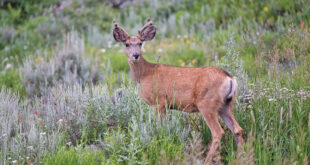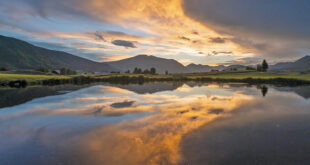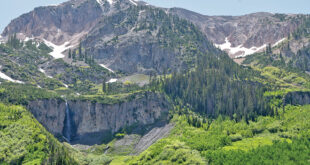My son’s wedding in Park City last weekend was wonderful and fun and pointed to an optimistic future for him, his wife and all of our family. Full of friends, relatives and a mention of their future parenting potential, it was a celebration of life in a beautiful place with beautiful people.
It was while coming home to Crested Butte from Park City that a bit of unwanted reality set in. The realism didn’t have anything to do with the wedding but, when the car thermometer hit 103 degrees for 100 miles, it brought to mind a potentially different future not only for them but for the children of their friends that were at the wedding and for their family’s future.
Travelling south and east on Highway 6 and I-70 in an air-conditioned Toyota, you can see and feel what the latest heat dome is doing pretty much everywhere south and west of our valley. The car’s thermometer topped out at 103 degrees near Green River. We had to get out to feel it, and while it was actually pleasant for a few minutes — it is a “dry heat” after all — the thought of hanging out for hours and doing anything in the middle of the day was not enticing.
The radio station said Grand Junction was only hitting a high of 98 on that Sunday but the coming weather forecast had GJ breaking well over 100 for several days in a row. Heat dome hell!
According to various news reports, the heat scorching the Western U.S. (along with places in Europe) is occurring amid the hottest weather ever reported on the planet. It’s as hot as it’s been in thousands of years…apparently 125,000 years, so say scientists. On Monday morning, the World Meteorological Organization declared that last week was the planet’s hottest on record. According to the Washington Post, “tracing climatic fluctuations back centuries and millennia is less simple and precise than checking records from satellites or thermometers. It involves poring through everything from ancient diaries to lake bed sediments to tree trunk rings. But the observations are enough to make paleoclimatologists, who study the Earth’s climate history, confident that the current decade of warming is exceptional relative to any period since before the last ice age, about 125,000 years ago.”
I see on the phone forecast that Crested Butte is forecast to hit the mid-80s mark next Tuesday in the middle of a string of 80-degree days. That is not normal. Remember when you wouldn’t go anywhere without a fleece because the days topped out in the 70s and, as soon as the sun set or a cloud even hid the sun, it was in the 40s and 50s even in August. Welcome to the new world.
We all understand living here sort of gives us a protective bubble from the heat dome. Being well off enough to live in or visit our sweet town at 9,000 feet is fortunate. Air conditioning takes away the sting for those that have it but a lot of people in the hottest places like Texas don’t.
The author of The Heat Will Kill You First: Life and Death on a Scotched Planet Jeff Goodell wrote in the New York Times last week that, “The extreme heat that is cooking many parts of the world this summer is not a freakish event — it is another step into our burning future. The wildfires in Canada, the orange Blade Runner skies on the East Coast, the hot ocean, the rapidly melting glaciers in Greenland and Antarctica and the Himalayas, the high price of food, the spread of vector-borne diseases in unexpected places — it is all connected, and it is all driven by rising heat.
“We need to start seeing hot days as more than an invitation to go to the beach or hang out at the lake. Extreme heat is the engine of planetary chaos. We ignore it at our peril. Because if there is one thing we should understand about the risks of extreme heat, it is this: All living things, from humans to hummingbirds, share one simple fate. If the temperature they’re used to — what scientists sometimes call their Goldilocks Zone — rises too far, too fast, they die.”
The heat dome is expected to intensify into the weekend with temperatures increasing each day. In places like Texas and Arizona, the heat index will set records and that’s not good for people.
Okay, it’s getting too gloomy for an editorial that started with a wedding. And it was a beautiful wedding – congrats to Ben and Taylor. So, I won’t end this piece in pessimism. Goodell says he sees the climate crisis as an “opportunity to change how we think about our relationship with nature and build a happier, healthier, more just world.” I like that.
We are obviously the fortunate ones to be where we are. Crested Butte must be one of the most protected places on earth for climate calamity. Humans are working on big solutions to deal with the increasing heat and climate issue. There are now tangible ways to remove CO2 from the atmosphere. Carbon capture is a real thing. Something as simple as protecting forests and planting trees helps a lot since trees absorb carbon dioxide. It is estimated that one large tree can provide a day’s supply of oxygen for up to four people and will absorb more than 48 pounds of carbon dioxide from the atmosphere in a year. That’s a good deal.
I’m not smart enough to understand carbon capture or how to remove CO2 from the atmosphere but I am smart enough to plant a tree. Diane and I went online to support the planting of one tree for every degree we drove through. Those 100 trees won’t make it less hot anytime soon but it is a start. It provides some hope — and Lord knows the foundation of any wedding is about hope for the future…
We have used The Nature Conservancy before but this time we went through onetreeplanted.org to plant 100 trees for the newly married couple, their future kids and their friends’ kids. It seems the least we could do as we drove through 103-degree heat in our air-conditioned car.
—Mark Reaman
 The Crested Butte News Serving the Gunnison Valley since 1999
The Crested Butte News Serving the Gunnison Valley since 1999






